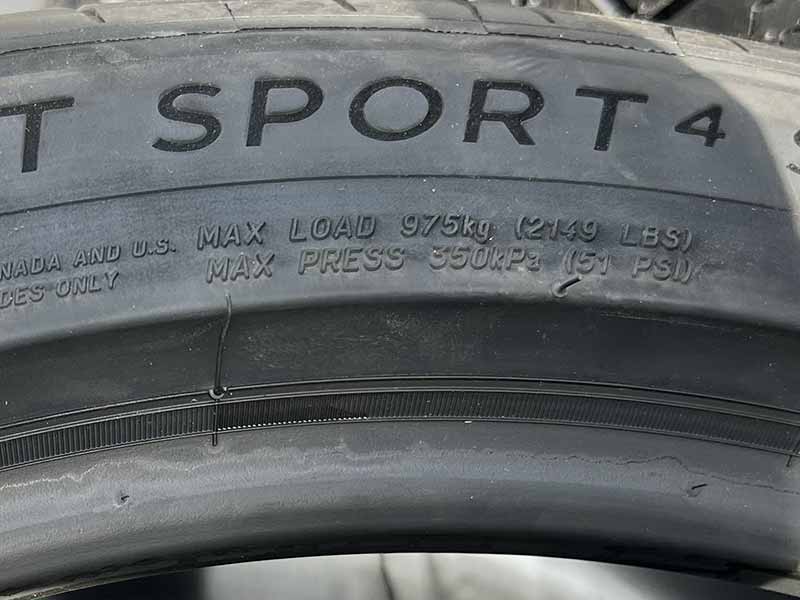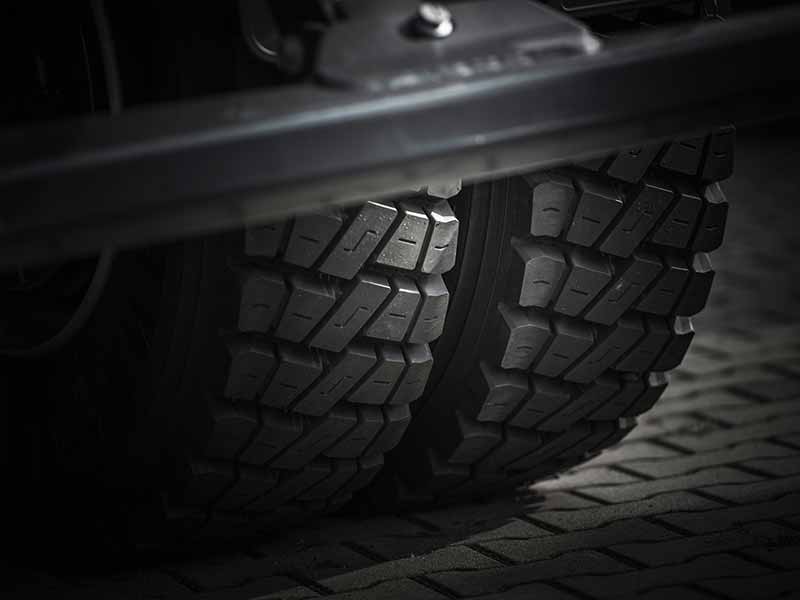Did you know that something as simple as a number on your tire’s sidewall can greatly impact your vehicle’s safety and performance? Learn why this often-overlooked detail, known as the tire load index, is essential for choosing the right tires and keeping you safe on the road.
Does Load Index Matter?
The tire load index indicates the maximum weight a tire can support when properly inflated. Understanding and maintaining the correct load rating for your vehicle helps prevent accidents, promotes optimal vehicle performance, and extends the life of your tires.
In this article, we’ll explore what load index is, why it matters, and how to find the correct index for your car or truck. We’ll also cover the dangers of using tires with an incorrect load rating and provide valuable tips on maintaining the proper load rating for a safe and smooth driving experience.
Let’s take a closer look.
What is Load Index?
Theoad rating is a critical piece of information when it comes to choosing the right tires for your car or truck. But what exactly is the load rating, and why does it matter? Let’s dive in and find out.
Defining Load Index
The tire load index is a number that represents the maximum weight a tire can carry when it’s inflated properly. It helps ensure that the tires on your vehicle can support the weight of your car, passengers, and any cargo you’re carrying. In short, the tire load carrying capacity helps you pick the right tires to keep your vehicle safe and performing well on the road.
Calculating Load Index
Each index number corresponds to a specific weight capacity, measured in pounds (or kilograms). The higher the load rating number, the more weight the tire can support.
For example:
- An index of 85 means the tire can support up to 1,135 pounds (or 515 kilograms)
- An index of 100 means the tire can support up to 1,764 pounds (or 800 kilograms)
As you can see, there’s a big difference in the weight capacity between those two examples.
Understanding Load Index Numbers
The index numbers range from around 70 to 126 for passenger cars and trucks. You’ll find the index listed on the tire’s sidewall, right after the tire size information. It usually looks something like this: “P215/65R15 95H”. In this example, “95” tells us that the tire can support up to 1,521 pounds (or 690 kilograms).
It’s important to note that the index number is for individual tires. To find out the total weight capacity for your vehicle, you’ll need to multiply the number by four (since your vehicle has four tires). So, if your tires have a index of 95, your vehicle can carry up to 6,084 pounds (or 2,760 kilograms) when all four tires are inflated properly.
Tire Load Index Chart
| Load Index | Carrying Capacity (pounds) | Carrying Capacity (kilograms) |
|---|---|---|
| 70 | 739 | 335 |
| 71 | 761 | 345 |
| 72 | 783 | 355 |
| 73 | 805 | 365 |
| 74 | 827 | 375 |
| 75 | 853 | 387 |
| 76 | 882 | 400 |
| 77 | 908 | 412 |
| 78 | 937 | 425 |
| 79 | 963 | 437 |
| 80 | 992 | 450 |
| 81 | 1,019 | 462 |
| 82 | 1,047 | 475 |
| 83 | 1,074 | 487 |
| 84 | 1,102 | 500 |
| 85 | 1,135 | 515 |
| 86 | 1,168 | 530 |
| 87 | 1,201 | 545 |
| 88 | 1,235 | 560 |
| 89 | 1,279 | 580 |
| 90 | 1,323 | 600 |
| 91 | 1,356 | 615 |
| 92 | 1,389 | 630 |
| 93 | 1,433 | 650 |
| 94 | 1,477 | 670 |
| 95 | 1,521 | 690 |
| 96 | 1,565 | 710 |
| 97 | 1,609 | 730 |
| 98 | 1,653 | 750 |
| Load Index | Carrying Capacity (pounds) | Carrying Capacity (kilograms) |
|---|---|---|
| 99 | 1,709 | 775 |
| 100 | 1,764 | 800 |
| 101 | 1,819 | 825 |
| 102 | 1,874 | 850 |
| 103 | 1,929 | 875 |
| 104 | 1,984 | 900 |
| 105 | 2,039 | 925 |
| 106 | 2,094 | 950 |
| 107 | 2,149 | 975 |
| 108 | 2,205 | 1,000 |
| 109 | 2,271 | 1,030 |
| 110 | 2,337 | 1,060 |
| 111 | 2,403 | 1,090 |
| 112 | 2,469 | 1,120 |
| 113 | 2,535 | 1,150 |
| 114 | 2,601 | 1,180 |
| 115 | 2,679 | 1,215 |
| 116 | 2,756 | 1,250 |
| 117 | 2,833 | 1,285 |
| 118 | 2,910 | 1,320 |
| 119 | 2,998 | 1,360 |
| 120 | 3,086 | 1,400 |
| 121 | 3,197 | 1,450 |
| 122 | 3,307 | 1,500 |
| 123 | 3,417 | 1,550 |
| 124 | 3,527 | 1,600 |
| 125 | 3,638 | 1,650 |
| 126 | 3,748 | 1,700 |
Why Load Index Matters
Now that you know what load index is, let’s explore why it’s so important for your vehicle’s safety and performance. Paying attention to this important measurement can help ensure a smooth, enjoyable ride while preventing dangerous situations on the road.
Here’s why it matters:
Ensuring Safety on the Road
When your tires can’t support the weight of your vehicle and its load, it puts undue stress on them, which can lead to tire failure. By using tires with the appropriate index, you reduce the risk of blowouts, punctures, or other tire-related issues that could cause accidents or leave you stranded.
Protecting Your Vehicle and Tires
Using tires with the correct load carrying capacity not only keeps you safe but also protects your vehicle and the tires themselves. Overloading your tires can cause excessive heat buildup, leading to premature wear, reduced tire life, and even structural damage to the tire. When you choose tires with the right index, you’ll help extend their lifespan and maintain their integrity, ultimately saving you time and money on replacements.
Preventing Accidents Due to Tire Failure
Tire failure is a leading cause of accidents on the road. A blown tire can quickly lead to loss of control, making it difficult to safely maneuver your vehicle. When your tires have the proper load index, you lower the likelihood of tire failure and minimize the chance of being involved in an accident.
Optimal Vehicle Performance
The load index also plays a crucial role in your vehicle’s overall performance. Tires with the appropriate load index offer better handling, improved braking, and a smoother ride. Plus, when your tires can support your vehicle’s weight correctly, it helps maintain the proper alignment and suspension, both of which are key to optimal performance.

How to Find the Correct Load Index for Your Vehicle
There are a few different ways to determine the correct load index, and we’ll cover each of them below:
Locating Load Index Information on the Tire Sidewall
One of the easiest ways to find the load of your vehicle is by checking the sidewall of your current tires. As mentioned earlier, the index number is located right after the tire size information, which usually looks something like this: “P215/65R15 95H”. In this example, “95” is the load index number.
Checking the Owner’s Manual or Vehicle Placard
Another way to find the correct load rating for your vehicle is to consult the owner’s manual. This handy guide contains essential information about your car or truck, including the recommended tire size and load index. If you don’t have the owner’s manual handy, you can also check the vehicle placard, which is typically located on the driver’s side door jamb, inside the fuel door, or in the glove box.
Consulting a Professional If Unsure
If you’re still unsure about the right load index for your vehicle or have questions about tire selection, it’s always a good idea to consult a professional. A knowledgeable mechanic or tire expert can help you determine the correct load rating based on your vehicle’s specifications, your driving habits, and your typical cargo load.

Dangers of Using Tires with Incorrect Load Index
Using tires with the wrong index rating can lead to several problems, putting you and your vehicle at risk. Let’s discuss the dangers of using tires with an incorrect load carrying capacity, highlighting why it’s crucial to choose the right tires for your car or truck.
Increased Risk of Tire Blowouts
Tires that aren’t designed to carry the weight of your vehicle are more likely to experience blowouts, as they’re unable to handle the stress. Tire blowouts can be dangerous and often result in loss of control, increasing the chances of an accident. By using tires with the correct load index, you’ll minimize the risk of blowouts and help keep yourself and your passengers safe.
Uneven Tire Wear and Shortened Tire Lifespan
When tires are overloaded, they can wear unevenly, leading to a shorter lifespan. Uneven tire wear can also impact your vehicle’s handling and overall performance. By ensuring your tires have the appropriate load index, you can promote even wear, extend their lifespan, and maintain a smooth, safe driving experience.
Compromised Handling and Braking Performance
Tires with the wrong load index can negatively affect your vehicle’s handling and braking capabilities. They may not provide the necessary traction, leading to poor steering control, longer stopping distances, and an increased risk of skidding or hydroplaning. Choosing tires with the correct load rating will help maintain optimal handling and braking performance, contributing to a safer and more enjoyable driving experience.
Legal Ramifications and Insurance Implications
In some cases, using tires with an incorrect load index can have legal and insurance-related consequences. If you’re involved in an accident and it’s determined that your tires were improperly rated for your vehicle’s weight, you may be held responsible for damages. Additionally, your insurance company may not cover the accident, leaving you to pay out of pocket for any repairs or medical bills.
Tips for Maintaining Proper Load Index
Now that we’ve covered the importance of load index and the dangers of using incorrectly rated tires, let’s discuss some tips for maintaining the proper load index for your vehicle. By following these guidelines, you’ll help keep your tires in good condition and contribute to a safer, more enjoyable driving experience.
Regularly Inspecting Tires for Wear and Damage
One of the best ways to ensure your tires maintain the appropriate load index is to regularly inspect them for signs of wear or damage. Check for uneven wear, punctures, cracks, or bulges in the sidewalls. If you notice any of these issues, it may be time to replace the affected tire(s) with new ones that have the correct load rating.
Proper Tire Inflation and Maintenance
Maintaining the right tire pressure is crucial for preserving your tires’ load-carrying capacity. Underinflated or overinflated tires can cause uneven wear and increase the risk of blowouts, negatively impacting the load index. Check your tire pressure at least once a month and adjust it according to your vehicle’s recommended levels, which can be found in the owner’s manual or on the vehicle placard.
Avoiding Overloading Your Vehicle
To help maintain the proper load index, be mindful of your vehicle’s weight capacity and avoid overloading it with passengers or cargo. Overloading can stress your tires, leading to a reduced load-carrying capacity and an increased risk of tire failure. Check your owner’s manual or the vehicle placard for your vehicle’s weight limits and adhere to them.
Replacing Tires with Correct Load Index When Necessary
Finally, when it’s time to replace your tires, always choose new ones with the appropriate load index for your vehicle. This will help ensure that your new tires can safely support the weight of your car or truck, contributing to a smoother, more reliable driving experience.
Resources
Below are some links you may find helpful when learning about tires
Final Thoughts
Paying attention to the often-overlooked detail of load index can help ensure a smoother, safer driving experience and extend the life of your tires. The key takeaway from this article is that understanding and maintaining the correct load index for your vehicle can prevent accidents, promote optimal performance, and protect your investment in your car or truck.
Consider this quotation by legendary race car driver Mario Andretti: “The racing car is not a mechanical exercise, it’s a human exercise with the human taking precedence.” Just as the driver is vital to a successful race, being attentive to details like the load index is essential for safe and enjoyable everyday driving.
Good luck and happy motoring.





